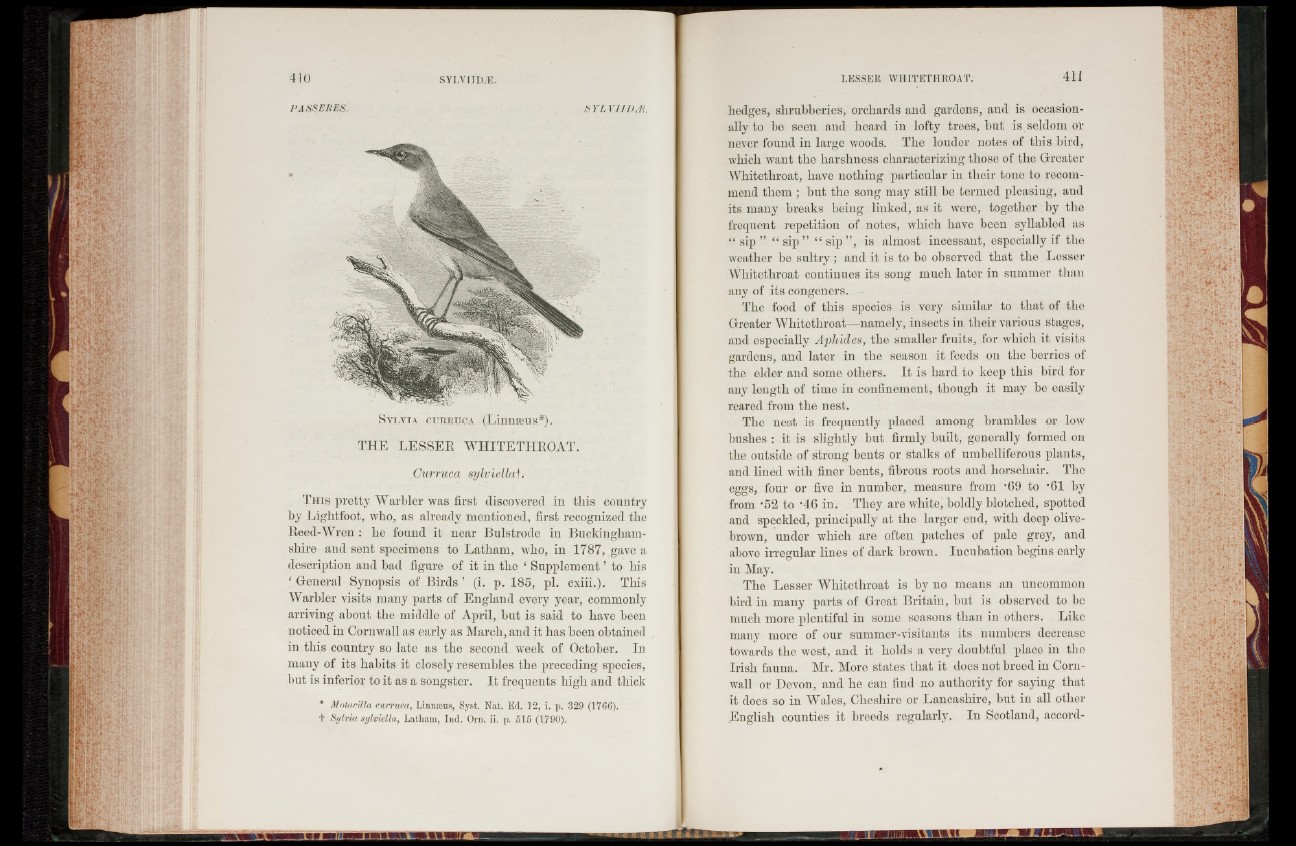
PASSU RES.
S y lv ia c u e e u c a (Linnaeus*).
THE LESSEE WHITE THROAT.
Curruca sylviellaj.
T h i s pretty Warbler was first discovered in this country
by Lightfoot, who, as already mentioned, first recognized the
Reed-Wren : lie found it near Bulstrode in Buckinghamshire
and sent specimens to Latham, who, in 1787, gave a
description and bad figure of it in the ‘ Supplement ’ to his
‘ General Synopsis of Birds ’ (i. p. 185, pi. cxiii.). This
Warbler visits many parts of England every year, commonly
arriving about the middle of April, but is said to have been
noticed in Cornwall as early as March, and it has been obtained
in this country so late as the second week of October. In
many of its habits it closely resembles the preceding species,
but is inferior to it as a songster. I t frequents high and thick
* Motacilla cuiruca, Linnseus, Syst. Nat. Ed. 12, i. p. 329 (1766).
+ Sylvia sylviella, Latham, Ind. Orn. ii. p. 515 (1790).
hedges, shrubberies, orchards and gardens, and is occasionally
to be seen and heard in lofty trees, but is seldom or
never found in large woods. The louder notes of this bird,
which want the harshness characterizing those of the Greater
Whitethroat, have nothing particular in their tone to recommend
them ; but the song may still be termed pleasing, and
its many breaks being linked, as it were, together by the
frequent repetition of notes, which have been syllabled as
“ sip ” “ sip ” “ sip ”, is almost incessant, especially if the
weather be su ltry ; and it is to be observed that the Lesser
Whitethroat continues its song much later in summer than
any of its congeners.
The food of this species is very similar to that of the
Greater Whitethroat—namely, insects in their various stages,
and especially Apliules, the smaller fruits, for which it visits
gardens, and later in the season it feeds on the berries of
the elder and some others. It is hard to keep this bird for
any length of time in confinement, though it may be easily
reared from the nest.
The nest is frequently placed among brambles or low
bushes : it is slightly but firmly built, generally formed on
the outside of strong bents or stalks of umbelliferous plants,
and lined with finer bents, fibrous roots and horsehair. The
eggs, four or five in number, measure from -69 to '61 by
from -52 to -46 in. They are white, boldly blotched, spotted
and speckled, principally at the larger end, with deep olive-
brown, under which are often patches of pale grey, and
above irregular lines of dark brown. Incubation begins early
in May.
The Lesser Whitethroat is by no means an uncommon
bird in many parts of Groat Britain, but is observed to be
much more plentiful in some seasons than in others. Like
many more of our summer-visitants its numbers decrease
towards the west, and it holds a very doubtful place in the
Irish fauna. Mr. More states that it does not breed in Cornwall
or Devon, and he can find no authority for saying that
it does so in Wales, Cheshire or Lancashire, but in all other
English counties it breeds regularly. In Scotland, accord